![]()
photos by Harry Wagner and Mike McAndrews
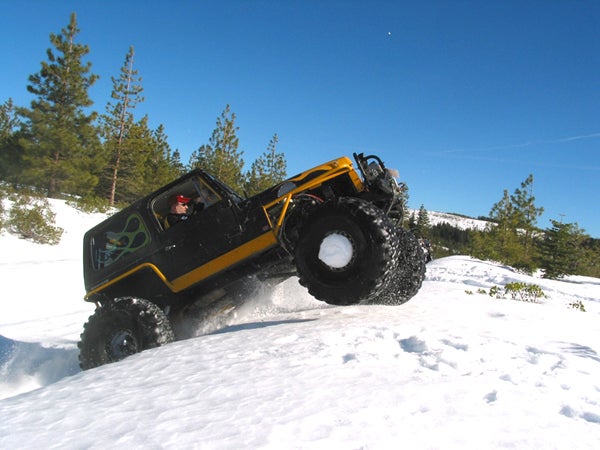
Some people store away their trucks in the winter when the weather gets cold, but snow wheeling can offer a lot of fun for the well prepared. Even a mild dirt road can be difficult to traverse if it is covered in several feet of snow, while difficult trails can be made easier when holes are filled in and the terrain evens out. Even if some terrain might become easier, the stakes are much higher. Breakage in a winter storm can leave you stranded in conditions that can lead to injury, and even death, for the unprepared.
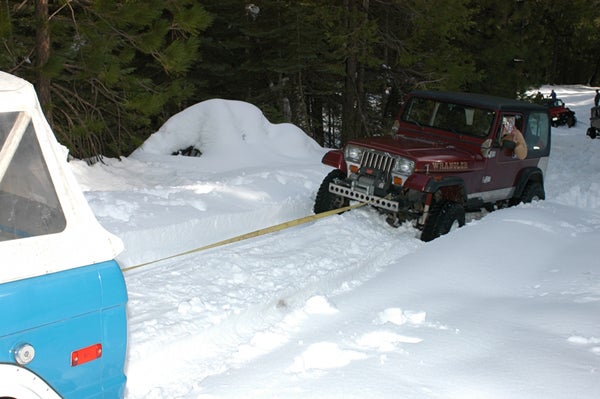 |
Tow hooks, a snatch strap, and a winch will all come in handy in the snow. A shovel is another cheap tool that can be worth its weight in gold when snow wheeling. |
Recovery Gear- Much of the recovery gear that you need for snow is the same as other terrain. Tow hooks, snatch straps, and winches are all important when traversing deep snow. A snow shovel is an important addition though, and they are relatively inexpensive. A shovel can be used to dig out tires, axles, and frames when they are pushing snow and you are not going anywhere.
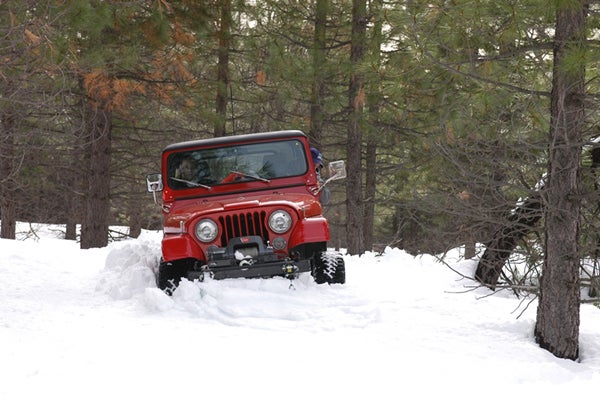 |
| Knowing how to read different types of snow is vital. Dry snow like this can be almost impossible to stay on top of and quickly strand a vehicle. |
Read The Snow- One of the most important techniques in snow wheeling is being able to “read” the snow. Soft, wet snow in the sun is quite different than hard, cold snow that is found on north facing slopes and in the shadows of trees. Understanding and anticipating these different consistencies is important. Wet, heavy snow is often the easiest to get on top of, while dry snow can cause fits.
Also be aware of slopes and shadows. If you need to go back out the same way you go in to a trail, take note of the snow consistency and any slopes. Are you going to be able to get back up the hills you went down once the snow gets soft and slushy?
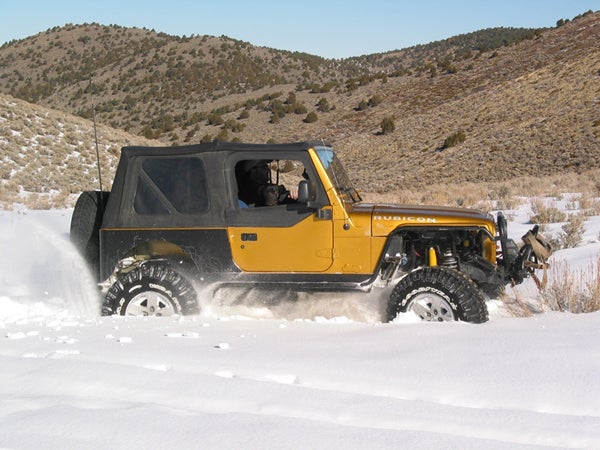 |
Get on the throttle at the wrong time (or in the wrong type of snow) and you are likely to find yourself sitting on the frame. Often times it is better to back off the throttle, back up, and try a different line. |
Don’t Spin- When you feel resistance in the snow, your natural reaction may be to try and power forward. Often times this just results in digging holes and if you spin too much your tires can melt the top layer of snow. When this water re-freezes, it turns into ice and can literally halt you in your tracks. Instead, ease off the throttle. If necessary, back up about a foot before trying to continue forward. Try different lines to the right or left of where you got stuck in order to find a way around the problem spot.
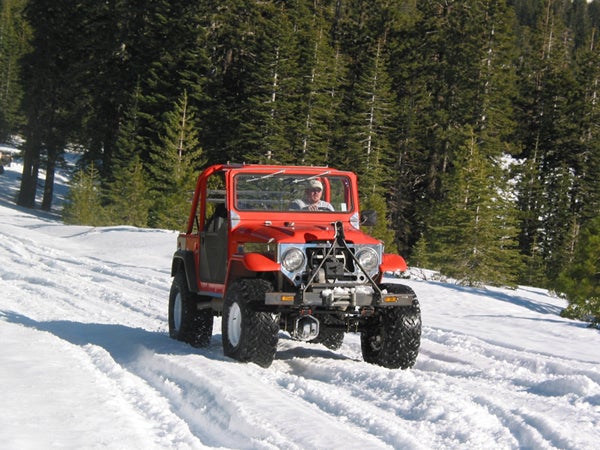 |
Dick Cepek Fun Countrys have a reputation for being some of the best tires in the snow. Their wide section width, mild tread pattern, and flexible carcass all contribute to this reputation. |
Wide, Flexible Tires- Dick Cepek Fun Country tires have a legendary reputation amongst snow wheelers. These tires offer a flexible carcass, mild tread pattern and wider than normal sizes. The wide section width provides a larger footprint and lowers contact pressure. Lowering pressures to single digits allows the flexible carcass to make an even larger contact patch. The mild tread pattern allows the tire to propel the vehicle across the snow without digging.
Note that we are talking about snow wheeling in this article, which has an entirely different set of parameters than driving on snow or ice covered roads. For snow covered roads you want narrow tires and high contact pressure to cut through the snow to the pavement below.
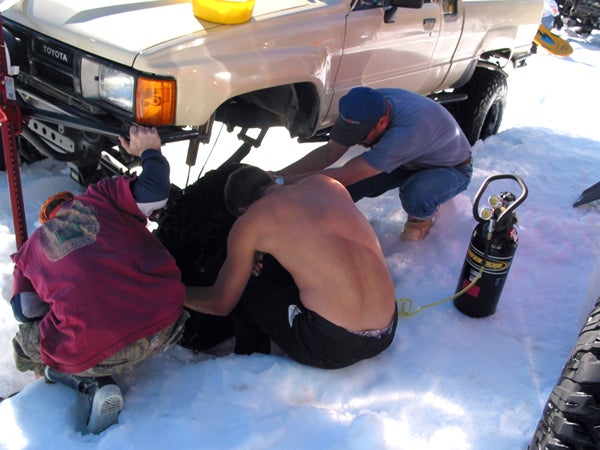 |
On board air, such as a Powertank, makes it possible to reseat a blown bead that can result from running low air pressure in the snow. |
Air Source- When you air down your tires, you need to have a way to air them back up at the end of the trail. Driving at freeway speeds with deflated tires can cause the carcass of the tire to heat up to the point of failure. And since we tend to air down to lower pressures in the snow than nearly any other terrain, there is the potential for the tire to unseat from the rim. Ever tried to change a tire in the snow? Unless you have an eight foot long Hi-Lift, it isn’t going to happen. Instead, it is recommended to have an onboard air source.
There are three basic varieties of air sources: electric, belt driven, and compressed CO2. Electric pumps are inexpensive and portable, but they are better suited for airing up tires than reseating beads. Belt driven compressors flow a lot of air, and with an auxiliary tank they can easily reseat a tire. CO2 tanks are another great choices, as they are light, portable, and have plenty of power to reseat a tire on the rim. Note that CO2 requires a temperature change and will be less effective in extremely cold (below zero) conditions.
Wrapping a ratchet strap around the circumference of the tire can help to push the bead of the tire out towards the edge of the rim. Just remember to unload the pressure on the ratchet strap as you add air to the tire or the strap may bind and break. Bring a tarp too so you don’t have to sit directly in the snow or risk losing your lug nuts.
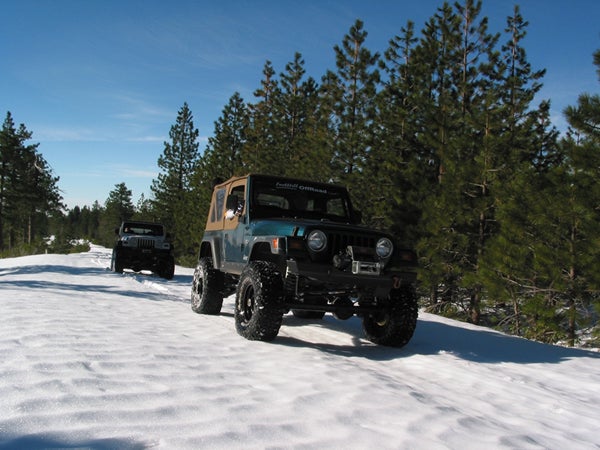 |
Traveling light and lowering air pressure in your tires can allow you to stay on top of the snow. Note the soft top; it still keeps the occupants warm but weighs a fraction of a hard top. |
Travel Light- In order to stay on top of the snow, it is best to keep your vehicle as light as possible. This can often be a delicate balance. Do you keep the hard top on your Jeep to stay warm and dry, or leave it at home to save a few hundred pounds? Plan around the weather, and take everything you might need but try to leave everything else behind. If you are travelling in a group, does each vehicle need a complete tool kit and a Hi-Lift jack when one will do for the entire group?
Locking Differentials- Locking differentials are a benefit in any terrain, but none more so than snow. Selectable lockers, such as the ARB Air Locker, are the best choice for snow duty. They can be turned off when traversing off camber slopes, allowing one tire per axle to propel the vehicle forward and the other tire to act as an “anchor” and keep the vehicle from sliding down the hill. Then when you get to the deep snow, the locker can be engaged and keep both wheels turning at the same speed. This will aid in keeping the tires from spinning, as discussed above.
Cooling System- It might seem counter-intuitive that you need a good cooling system in single digit temperatures. Snow provides a high amount of resistance that can lead to boiling radiators and roasting torque convertors. Make certain that your radiator does not become clogged with snow, which can limit air flow through the radiator and the engine bay. If you have an automatic, run the biggest transmission cooler you can fit under your vehicle to keep it running cool. Breaking trail is particularly hard on the cooling system, so alternate who is in front when wheeling with a group. New, clean fluids are more efficient and effective than old fluids, so stick to regular maintenance schedules. This includes the right mixture of fresh anti-freeze. Running straight water can caused frozen cooling systems and even cracked blocks under extreme conditions.
Dress Appropriately- These tips are intended to be oriented towards your vehicle, but if you are cold and wet even the best buggy in the world won’t put a smile on your face. Staying dry is paramount to staying warm, particularly as the day progresses into night. During the winter daylight hours are short. Dress in layers in order to easily shed or retain heat. Also focus on synthetic materials, such as inner layers that wick away moisture from your body and outer layers that repel water and wind. “Cotton kills” is the mantra of mountaineers. Sturdy, warm footwear is essential as well. Goggles are another useful item if you are in an open air vehicle, particularly if it is windy.
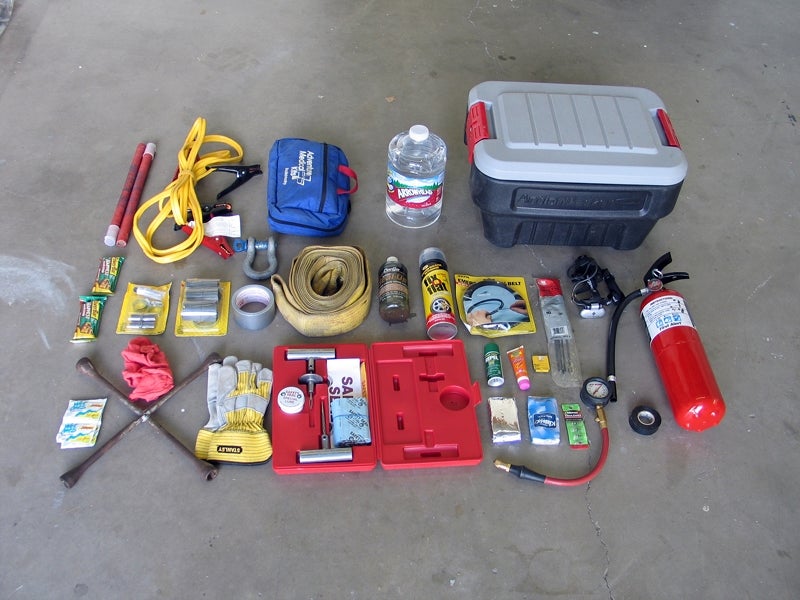 |
Water? Check. Power bars? Check. Snatch strap and tarp? Double check. When you go wheeling in extreme conditions you need to go prepared. |
Be Prepared- Winter wheeling, and snow wheeling in particular, require extra precautions. When wheeling in the snow it is advisable to bring along a sleeping bag, extra water, and food such as energy bars. Leave the alcohol at home since it actually lowers your body temperature. Even within the shelter of your vehicle, unplanned nights in the snow can be deadly for the unprepared. Let someone know where you are going and when they should expect your return, so if your trip does not go as planned help will have a head start. Also always travel in groups of vehicles for safety as getting stuck in the snow is not an uncommon occurrence.


 Your Privacy Choices
Your Privacy Choices